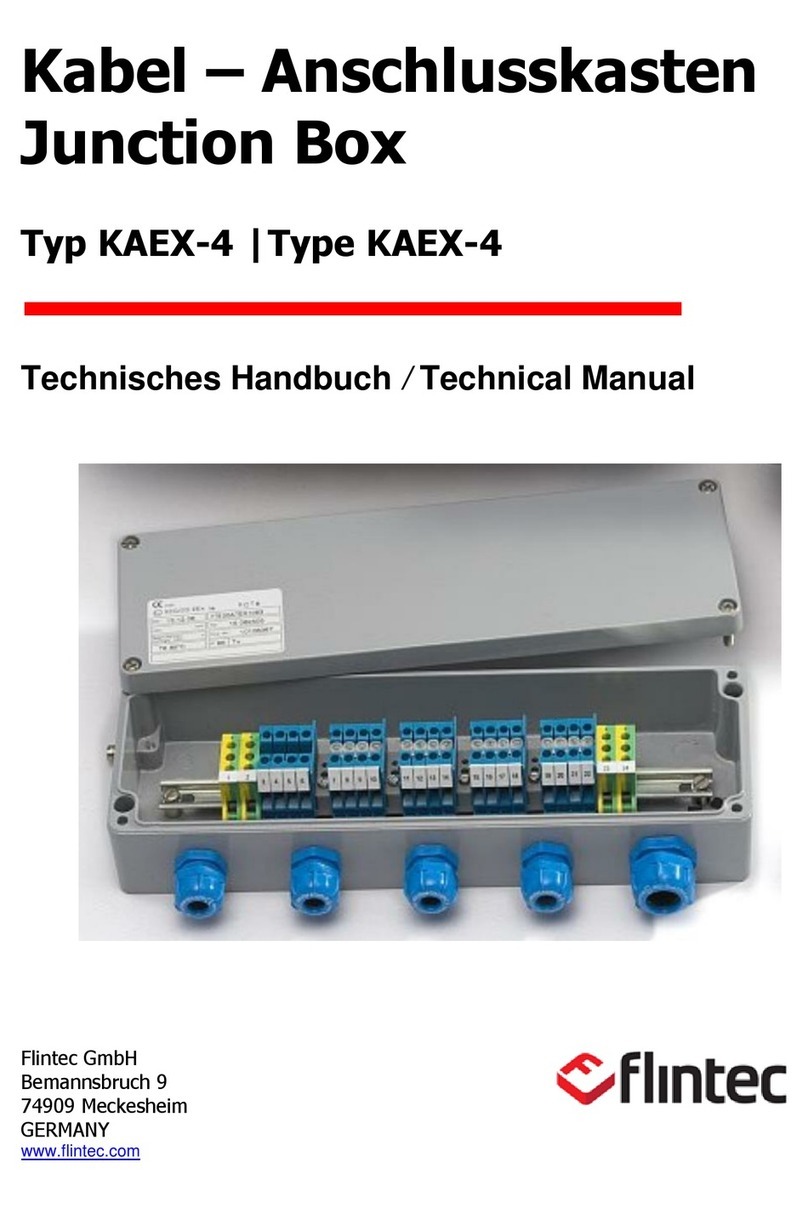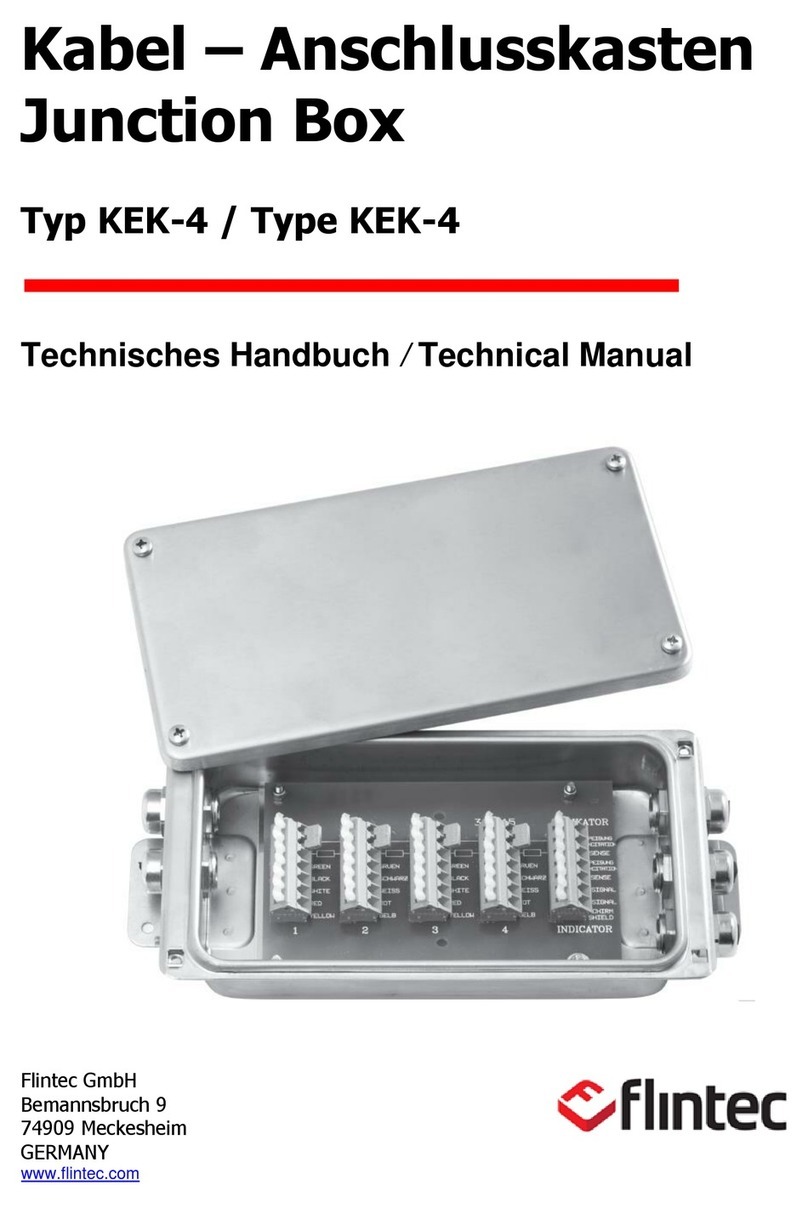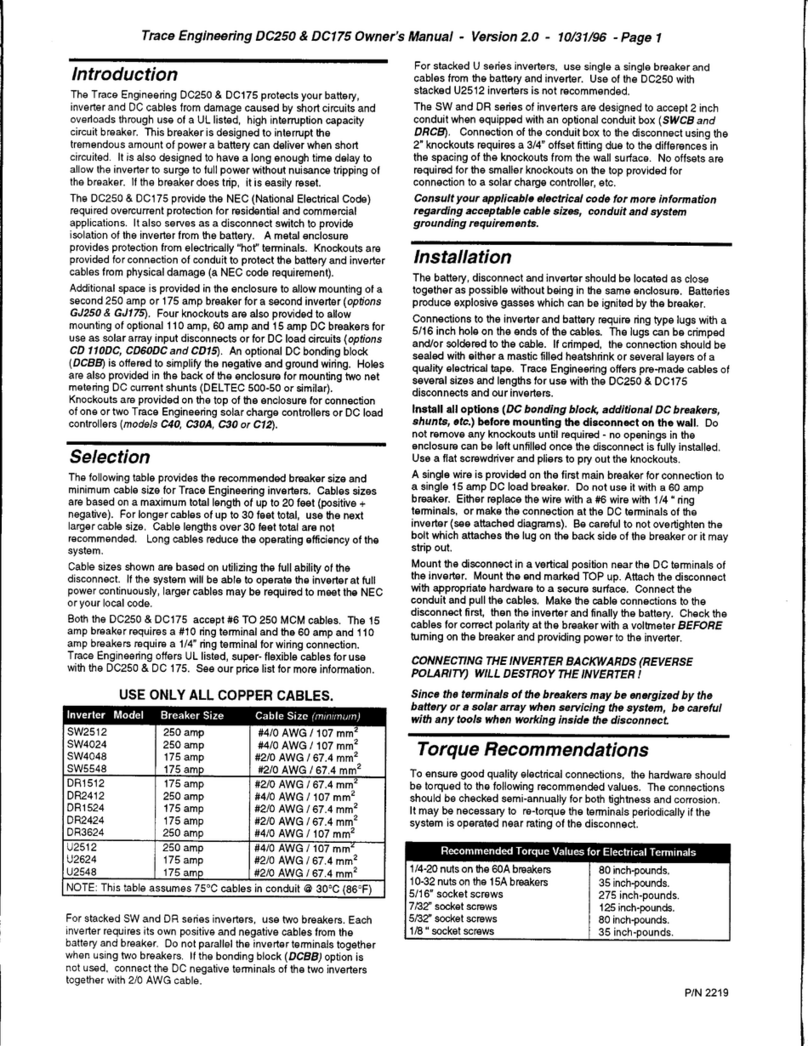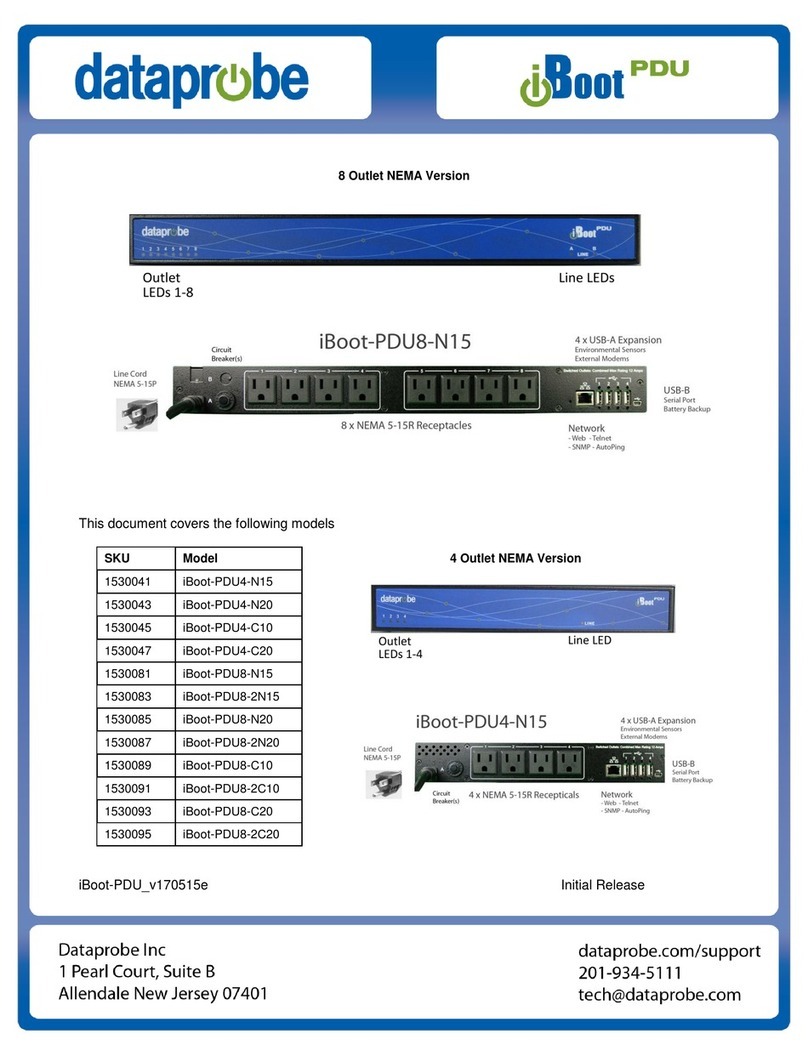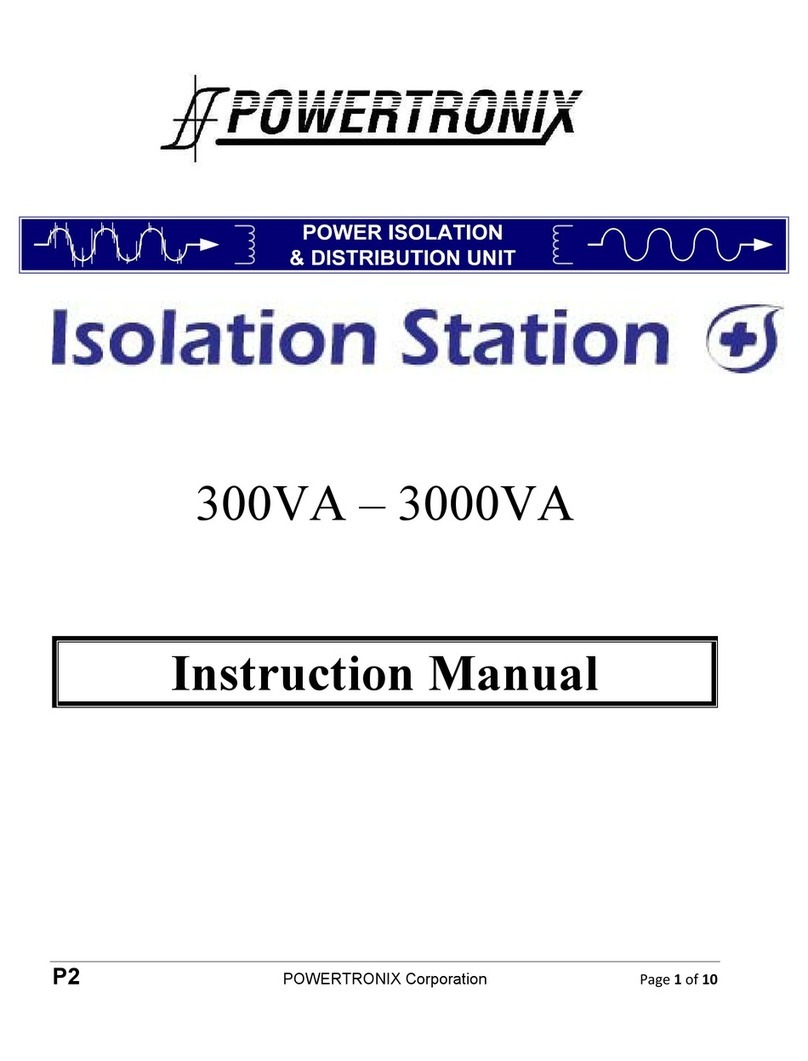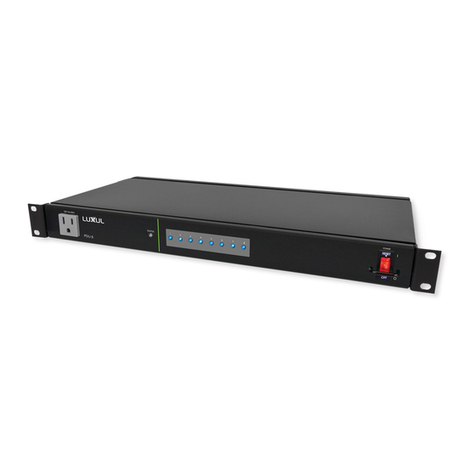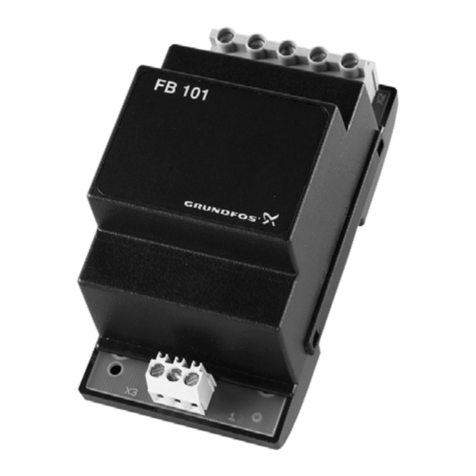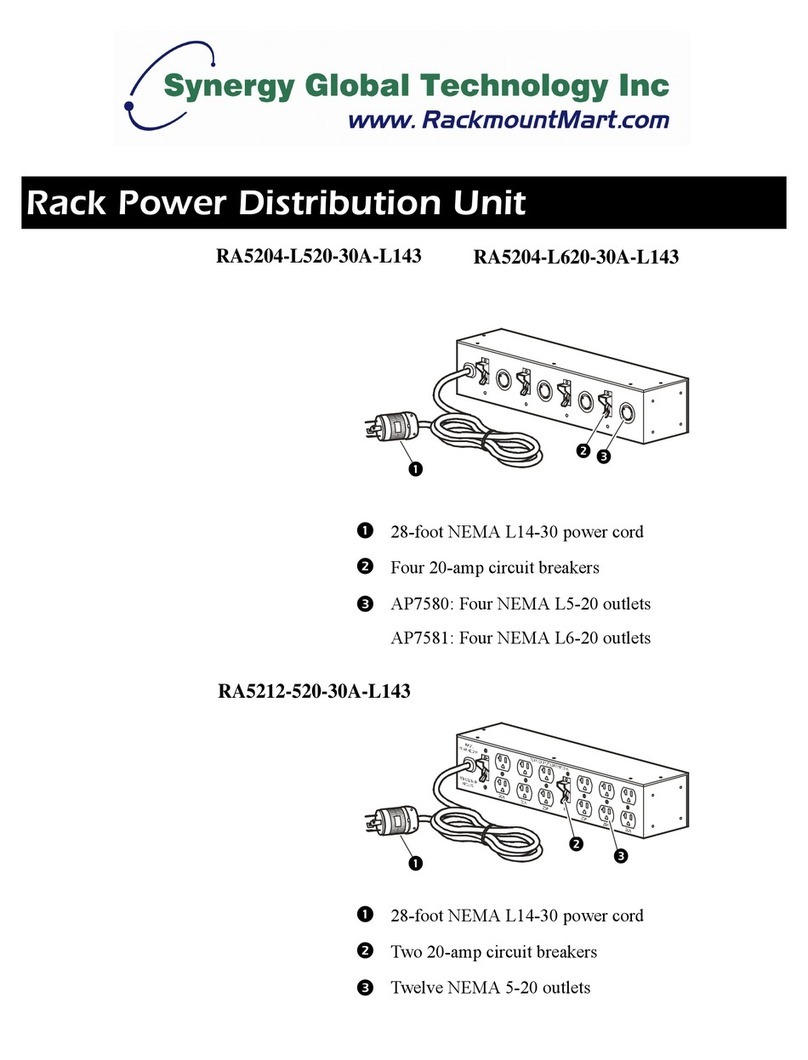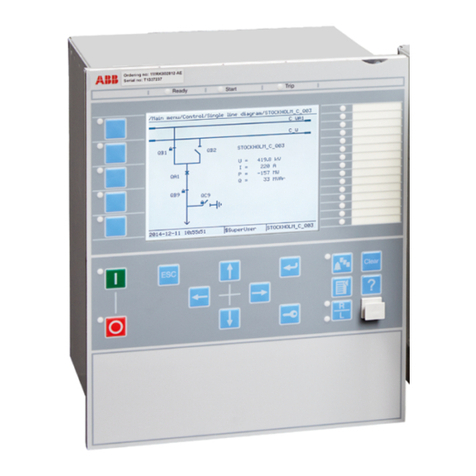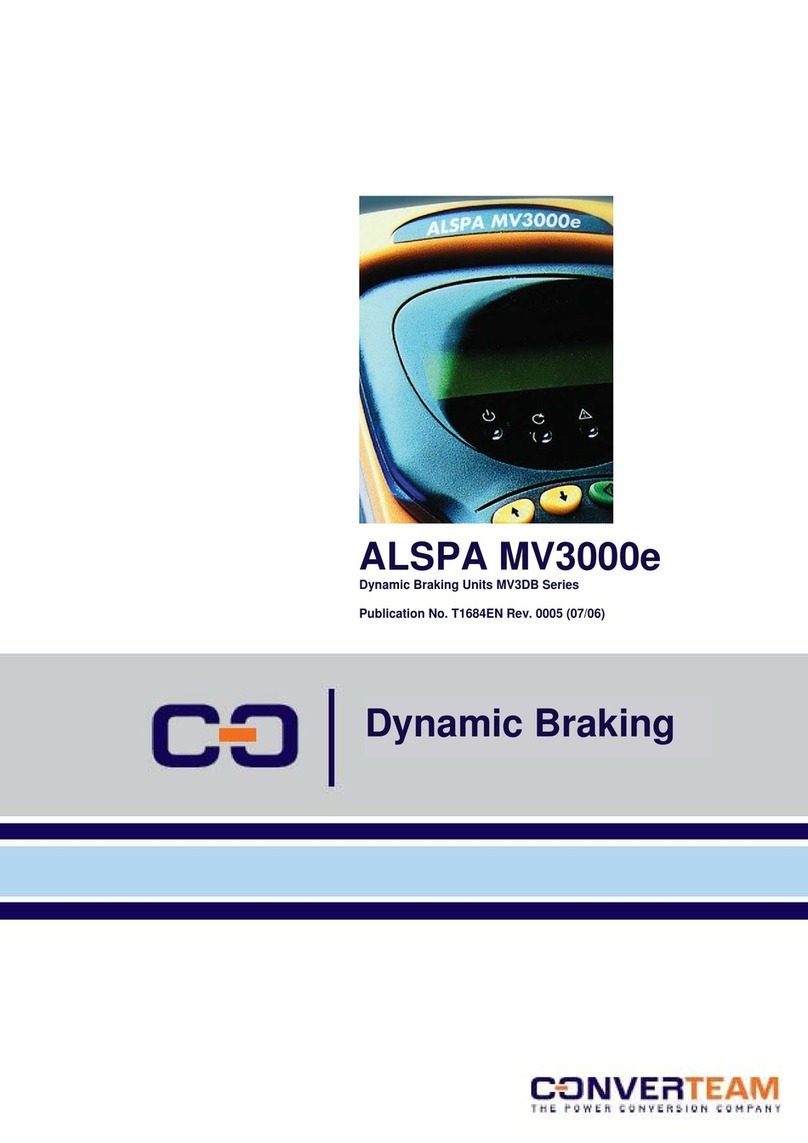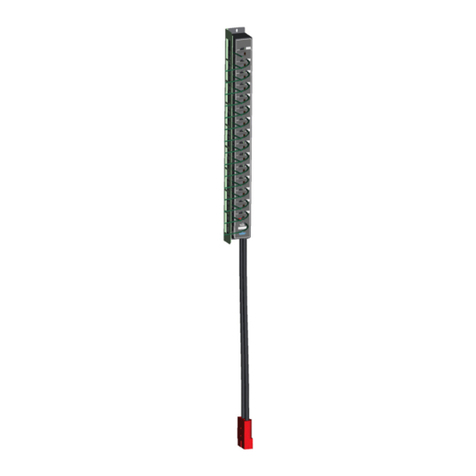Flintec KPK-4 User manual

Kabelanschlusskasten Typ KPK Technisches Handbuch, Rev. 1.01 September 2016
Junction Box Type KPK Technical Manual
Seite / Page 2/8
Inhaltsverzeichnis
Produkthaftung...................................................................................................................................................3
Sicherheitshinweise...........................................................................................................................................3
Allgemeines und technische Daten..................................................................................................................4
Mechanische Installation...................................................................................................................................4
Elektrische Anschlüsse .....................................................................................................................................4
Anschluss der Wägezellenkabel.......................................................................................................................4
Anschluss des Ausgangskabels.......................................................................................................................5
Eckenabgleich bei Waagen mit FLINTEC-Wägezellen....................................................................................5
Table of contents
RIGHTS AND LIABILITIES..................................................................................................................................6
Safety Instructions .............................................................................................................................................6
Introduction and technical Data........................................................................................................................7
Mechanical Installation ......................................................................................................................................7
Electrical Connections.......................................................................................................................................7
Load Cell Cable Connection..............................................................................................................................7
Output Cable Connection ..................................................................................................................................8
Corner Correction at Scales with Flintec Load Cells......................................................................................8

Kabelanschlusskasten Typ KPK Technisches Handbuch, Rev. 1.01 September 2016
Junction Box Type KPK Technical Manual
Seite / Page 3/8
PRODUKTHAFTUNG
Alle Rechte vorbehalten.
Kein Teil dieser Veröffentlichung darf ohne vorherige schriftliche Genehmigung durch die Flintec GmbH
kopiert, gespeichert oder in irgendeiner Form oder mit irgendwelchen Mitteln übertragen oder wieder-
verwendet werden –sei es mechanisch, fotokopiertechnisch oder jegliche andere Form der Vervielfältigung
und Archivierung.
Im Hinblick auf den Gebrauch der enthaltenen Information ist sich die Flintec GmbH keinerlei Verstoßes
gegen das Patentrecht bewußt. Trotz größter Sorgfalt bei der Erstellung dieses Handbuchs übernimmt Flintec
keinerlei Verantwortung für Fehler oder Auslassungen in diesem Handbuch. Jegliche Haftungsansprüche für
Schäden, die durch Gebrauch der in diesem Handbuch enthaltenen Information entstehen können, werden
ausgeschlossen.
Der Inhalt dieses Handbuchs wird als richtig und zuverlässig betrachtet. Sollten jedoch Fehler jeglicher Art
gefunden werden, dann ist die Flintec GmbH um jeden Hinweis dankbar. Flintec kann allerdings keinerlei
Haftung für direkte oder indirekte Schäden übernehmen, die durch den Gebrauch dieses Handbuchs
entstehen können.
Die FLINTEC GmbH bewahrt sich das Recht, dieses Handbuch jederzeit ohne vorherige Ankündigung zu
überarbeiten und den Inhalt zu verändern.
Weder Flintec noch alle angeschlossenen Tochtergesellschaften können von dem Käufer dieses Produktes
oder Dritten haftbar gemacht werden für Schäden, Verluste, Kosten oder sonstige Ausgaben, die in Folge von
Unfall, falscher Anwendung und Missbrauch dieses Produktes oder unbefugter Modifikation, Reparatur oder
Veränderung am Produkt oder durch den Ausfall bei sachgemäßer Verwendung gemäß den Flintec
Bedienungs- und Wartungsanleitungen angefallen sind.
FLINTEC kann nicht haftbar gemacht werden für Schäden oder Probleme, die durch die Anwendung von
Zubehör oder anderen Verbrauchsgütern enstanden sind, die nicht als originale Flintec Produkt ausgewiesen
sind.
Wichtig: Änderungen am Inhalt dieses Handbuchs ohne vorherige Ankündigung sind vorbehalten.
Copyright © 2007 der Flintec GmbH, 74909 Meckesheim, Bemannsbruch 9, Germany
SICHERHEITSHINWEISE
VORSICHT LESEN Sie diese Handbuch VOR dem Betrieb oder der Wartung des Gerätes.
BEFOLGEN Sie die Anweisungen sorgfältig. Bewahren Sie dieses Handbuch als Nachschlagewerk
sicher auf. ERLAUBEN SIE KEINER ungeschulten Person die Bedienung, Reinigung,
Überprüfung, Reparatur oder Eingriff in dieses Gerät. TRENNEN Sie das Gerät IMMER vom
Spannungsnetz bevor Reinigungs- oder Wartungsmaßnahmen ausgeführt werden.
KONTAKTIEREN Sie FLINTEC für Information, Service und Ersatzteile.
WARNUNG ERLAUBEN SIE NUR BERECHTIGTEN PERSONEN DEN SERVICE AN DIESEM
GERÄT. LASSEN SIE SORGFALT WALTEN BEIM PRÜFEN, TESTEN UND EINSTELLEN,
WENN DAS GERÄT UNTER ELEKTRISCHER SPANNUNG STEHT. EINE MISSACHTUNG KANN
ZU KÖRPERSCHÄDEN FÜHREN.
WARNUNG FÜR DAUERHAFTEN SCHUTZ GEGEN ELEKTRISCHE GEFAHREN DARF DAS
GERÄT NUR AN EINEM SPANNUNGSVERSORGUNGSNETZ MIT FUNKTIONSFÄHIGER
VERBINDUNG ZUR SCHUTZERDE BETRIEBEN WERDEN. ENTFERNEN SIE NIEMALS DIE
VERBINDUNG ZUM SCHUTZKONTAKT/SCHUTZLEITER.
WARNUNG TRENNEN SIE ALLE VERBINDUNGEN ZUR SPANNUNGSVERSORGUNG
BEVOR DIE SICHERUNG GEWECHSELT WIRD ODER SONSTIGE SERVICEARBEITEN
AUSGEFÜHRT WERDEN.
WARNUNG VOR DEM ANSCHLIESSEN/TRENNEN VON INTERNEN ELEKTRISCHEN
KOMPONENTEN ODER DEM VERBINDEN MIT ELEKTRISCHEN GERÄTEN TRENNEN SIE
IMMER DIE SPANNUNGSVERSORGUNG UND WARTEN SIE FÜR MINDESTENS 30
(DREISSIG) SEKUNDEN BEVOR SIE DIESE MASSNAHMEN AUSFÜHREN. EIN
NICHTBEACHTEN DIESER WARNUNG KANN ZU EINEM GERÄTESCHADEN ODER ZUR
ZERSTÖRUNG DES GERÄTES ODER ZU KÖRPERSCHÄDEN FÜHREN.
VORSICHT ERGREIFEN SIE ALLE VORSICHTSMASSNAHMEN FÜR DEN UMGANG MIT
ELEKTROSTATISCH EMPFINDLICHEN GERÄTEN.

Kabelanschlusskasten Typ KPK Technisches Handbuch, Rev. 1.01 September 2016
Junction Box Type KPK Technical Manual
Seite / Page 4/8
ALLGEMEINES UND TECHNISCHE DATEN
Der Polyester –Anschlusskasten ist für den Parallel-Anschluss von bis zu 4 Wägezellen vorbereitet.
Gehäuse-Typ
Anzahl Wägezellen
Gehäuseabmessungen
Eingänge
Ausgang
KPK-4
bis 4
75 x 230 x 50 mm
4x M12
1x M16
Der Anschluss zum Anzeigegerät bzw. zur Auswerteelektronik erfolgt über ein abgeschirmtes 6-adriges
Signalkabel. Eine Eckenkorrektur erfolgt mit Widerständen und/oder Potentiometer.
Gehäusematerial:
Polyester
Gehäuseschutzart:
IP66
Kabel-Anschluss:
Mit Federklemmen
Eckenabgleich:
Mit austauschbaren Festwiderständen oder Potentiometer
MECHANISCHE INSTALLATION
Als Einbauort sollte ein möglichst trockener und vor Umwelteinflüssen geschützter Ort gewählt werden.
ELEKTRISCHE ANSCHLÜSSE
1
2
2
1
1
2
2
1
Abbildung 1: Abmessungen in [mm]
Die Erdungsschraube (siehe (2) in Abb.1) ist mit der Schutzerde zu verbinden bzw. es ist eine elektrisch
leitende Verbindung zu den Wägemodulen herzustellen (Potentialausgleich).
Die Anschlussreihenfolge der Wägezellen sollte mit den Ecken der Waage übereinstimmen, also
Ecke 1 = Wägezelle 1, Ecke 2 = Wägezelle 2, usw.
ANSCHLUSS DER WÄGEZELLENKABEL
Die Kabelverschraubung (siehe (1) in Abb. 1) muß gelockert werden. Danach wird das Wägezellenkabel
soweit in die Verschraubung eingeführt, bis der Schrumpfschlauch vollständig in der Verschraubung ver-
schwindet. Die Anschlussleitungen unterhalb der Platine durchführen und am oberen Ende der Platine wieder
nach vorne holen. Danach können die Anschlussleitungen wie folgt aufgelegt und festgeklemmt werden:
Leitungsfarbe
Beschreibung
Klemmenbezeichnung
gelb
= Kabelschirm
Schirm / Shield
rot
= Signal –(Ausgang –)
rot / red
weiss
= Signal + (Ausgang +)
weiss / white
schwarz
= Speisung –/ Excitation –(Eingang –)
schwarz / black
(ggfs. braun)*
= Rückführung –/ Sense –
schwarz / black
grün
= Speisung + / Excitation + (Eingang +)
grün / green
(ggfs. blau)*
= Rückführung + / Sense +
grün / green
* bei Wägezellen mit 6-Leiter Anschluss
Wenn alle Leitungen angeklemmt sind, müssen die Kabelverschraubungen festgezogen werden. Bitte prüfen
Sie anschließend, ob Dichtigkeit und Zugentlastung vorhanden sind.

Kabelanschlusskasten Typ KPK Technisches Handbuch, Rev. 1.01 September 2016
Junction Box Type KPK Technical Manual
Seite / Page 5/8
ANSCHLUSS DES AUSGANGSKABELS
Das Signalkabel (Verbindung zwischen dem Anschlusskasten und der nachgeschalteten Auswerteelektronik)
sollte ein 6 –adriges abgeschirmtes Kabel sein und so kurz wie möglich gehalten werden. Da dieses Kabel in
der Regel einen größeren Durchmesser als das Wägezellenkabel hat, wird hierfür die mittlere etwas größere
Kabeleinführung verwendet. Da Signalkabel je nach Typ und Hersteller verschiedene Leitungsfarben haben,
wählen Sie die Farben entsprechend selbst aus.
Leitungsfarbe, Beispiel
Beschreibung / Klemmenbezeichnung
Äußeres Kabelgeflecht
= Kabelschirm
rosa
= Signal –(Ausgang –/ Output –)
weiß
= Signal + (Ausgang + / Output +)
grau
= Rückführung –/ Sense –
braun
= Speisung –/ Excitation –(Eingang –/ Input –)
gelb
= Rückführung + / Sense +
grün
= Speisung + / Excitation + (Eingang + / Input +))
ECKENABGLEICH BEI WAAGEN MIT FLINTEC-WÄGEZELLEN
Flintec-Wägezellen werden mit relativ engen Toleranzen gebaut, so daß in den meisten Fällen kein zusätz-
licher Eckenabgleich erforderlich ist. Die besten Voraussetzungen sind gegeben, wenn Wägezellen aus der
gleichen Klasse verwendet werden (Kennzeichnung erfolgt durch die Buchstaben A bis I auf der Verpackung
neben dem Typenschild). Hinweis: Eckenfehler können auch mechanische Ursachen haben, z.B. Neigung der
Wägezellen-Montagefläche.
Vorgehensweise:
1. Steckbrücken JP1 bis JP4 sollen installiert sein, damit sind die Potentiometer ohne Funktion.
2. 0-Ohm-Steckbrücken an Stelle von Festwiderständen müssen installiert sein (Auslieferungszustand).
3. Ermittlung des Anzeigewertes je Ecke. Möglichst mit erhöhter Auflösung des Anzeigegerätes (z.B. Faktor
10 oder höher) oder, wenn dies nicht möglich ist, durch Ausmessen des digitalen Ziffernsprunges der
Gewichtsanzeige mit entsprechenden Prüfgewichten.
4. Die Ecke mit dem niedrigsten Anzeigewert ist der Ausgangspunkt für die nun anschließende Korrektur.
Dementsprechend wird die Differenz der anderen Ecken in Bezug auf diese " Basisecke" errechnet.
5. Berechnung des Korrekturwiderstandes wie folgt:
Korrekturwiderstand in [] =
Abweichung in [kg]
X Eingangswiderstand der Wägezelle in [] *
Prüflast in [kg]
* Eingangswiderstand 1100 für:
BK2, SB4, SB5, SB6, SB14, SLB, ZLB, UB1, UB5, UB6, PB, RC3
Eingangswiderstand 400 für:
RC1, SB2
Beispiel 1: 1100 -Wägezellen
Eckenfehler 0,1 kg bei Prüflast 500 kg
0,1 kg
x
1100
=
0,22
500 kg
Beispiel 2: 400 -Wägezellen
Eckenfehler 10 kg bei Prüflast 5000 kg
10 kg
x
400
=
0,8
5000 kg
6. Einbau des Korrekturwiderstandes an Stelle der 0 Ohm Steckbrücke im Kabelkasten in die Speisung der
entsprechenden Wägezelle bzw. Einstellung mittels Potentiometer (siehe unten).
7. Ecken nochmals überprüfen. Gegebenenfalls das beschriebene Vorgehen wiederholen.
Hinweis: 50 ppm Widerstände für den Eckenabgleich sind als Satz mit 14 Werten von 0,22 bis 4,7
(jeweils 10 Stück) unter der Artikel -Nr. 5200-030 lieferbar.
Einstellung mittels Potentiometer
Der ermittelte Korrekturwiderstand dient auch als Startpunkt für die Eckenkorrektur mittels Potentiometer P1
bis P4 (25-Gang, 10 Ohm Cermet- Präzisions-Trimmer). Im Auslieferungszustand befinden sich alle Potentio-
meter in Mittelstellung (5 Ohm) und sind durch die Steckbrücken JP1 bis JP4 außer Funktion gesetzt
(gebrückt). Soll ein Potentiometer aktiviert werden, so ist die entsprechende Steckbrücke JPx zu entfernen.
Zunächst wird das Potentiometer im Uhrzeigersinn bis zum Anschlag gedreht (Knackgeräusch). Anschließend
wird durch Drehen im Gegen-Uhrzeigersinn der berechnete Widerstandswert eingestellt.
Hinweise zur
Poti-Eınstellung:
Geeigneten Schraubendreher verwenden !
Eine Umdrehung entspricht ca. 0,4 Ohm
Rechtsanschlag = 0 Ohm
Linksanschlag = 10 Ohm
0 Ohm Steckbrücken an Stelle der Festwiderstände bleiben installiert
Im Anschlusskasten befindet sich auch eine Trockentablette in einer Plastiktüte. Bitte die Plastiktüte entfernen
und die Trockentablette zur Aufnahme von evtl. sich bildender Feuchtigkeit im Anschlusskasten belassen.

Kabelanschlusskasten Typ KPK Technisches Handbuch, Rev. 1.01 September 2016
Junction Box Type KPK Technical Manual
Seite / Page 6/8
Anschließend die Deckeldichtung auf Schmutz überprüfen und den Deckel mit dem Anschlusskasten
gleichmäßig fest verschrauben.
RIGHTS AND LIABILITIES
All rights reserved.
No part of this publication may be reproduced, stored in a retrieval system, or transmitted in any form or by
any means, mechanical, photocopying, recording, or otherwise, without the prior written permission of Flintec
GmbH
No patent liability is assumed with respect to the use of the information contained herein. While every
precaution has been taken in the preparation of this book, FLINTEC assumes no responsibility for errors or
omissions. Neither is any liability assumed for damages resulting from the use of the information contained
herein.
The information herein is believed to be both accurate and reliable. FLINTEC, however, would be obliged to
be informed if any errors occur. FLINTEC cannot accept any liability for direct or indirect damages resulting
from the use of this manual.
FLINTEC reserves the right to revise this manual and alter its content without notification at any time.
Neither FLINTEC nor its affiliates shall be liable to the purchaser of this product or third parties for damages,
losses, costs, or expenses incurred by purchaser or third parties as a result of: accident, misuse, or abuse of
this product or unauthorized modifications, repairs, or alterations to this product, or failure to strictly comply
with FLINTEC operating and maintenance instructions.
FLINTEC shall not be liable against any damages or problems arising from the use of any options or any
consumable products other than those designated as Original FLINTEC Products.
NOTICE: The contents of this manual are subject to change without notice.
Copyright © 2007 by Flintec GmbH, 74909 Meckesheim, Bemannsbruch 9, Germany
SAFETY INSTRUCTIONS
CAUTION READ this manual BEFORE operating or servicing this equipment. FOLLOW
these instructions carefully. SAVE this manual for future reference. DO NOT allow untrained
personnel to operate, clean, inspect, maintain, service, or tamper with this equipment.
ALWAYS DISCONNECT this equipment from the power source before cleaning or performing
maintenance. CALL FLINTEC ENGINEERING for parts, information, and service.
WARNING ONLY PERMIT QUALIFIED PERSONNEL TO SERVICE THIS EQUIPMENT.
EXERCISE CARE WHEN MAKING CHECKS, TESTS AND ADJUSTMENTS THAT MUST BE
MADE WITH POWER ON. FAILING TO OBSERVE THESE PRECAUTIONS CAN RESULT
IN BODILY HARM.
WARNING FOR CONTINUED PROTECTION AGAINST SHOCK HAZARD CONNECT
TO PROPERLY GROUNDED OUTLET ONLY. DO NOT REMOVE THE GROUND PRONG.
WARNING DISCONNECT ALL POWER TO THIS UNIT BEFORE REMOVING THE
FUSE OR SERVICING.
WARNING BEFORE CONNECTING/DISCONNECTING ANY INTERNAL ELECTRONIC
COMPONENTS OR INTERCONNECTING WIRING BETWEEN ELECTRONIC EQUIPMENT
ALWAYS REMOVE POWER AND WAIT AT LEAST THIRTY (30) SECONDS BEFORE ANY
CONNECTIONS OR DISCONNECTIONS ARE MADE. FAILURE TO OBSERVE THESE
PRECAUTIONS COULD RESULT IN DAMAGE TO OR DESTRUCTION OF THE
EQUIPMENT OR BODILY HARM.
CAUTION OBSERVE PRECAUTIONS FOR HANDLING ELECTROSTATIC SENSITIVE
DEVICES.

Kabelanschlusskasten Typ KPK Technisches Handbuch, Rev. 1.01 September 2016
Junction Box Type KPK Technical Manual
Seite / Page 7/8
INTRODUCTION AND TECHNICAL DATA
The Polyester junction box is designed for the parallel connection of load cells.
Type
No. of load cells
Housing size
Inputs
Output
KPK-4
up to 4
75 x 230 x 50 mm
4x M12
1x M16
The junction box type KPK can be connected to the instrumentation with a shielded 6-wire signal cable.
The corner correction is done with resistors and/or potentiometer.
Housing material:
Polyester
Protection class:
IP66
Cable connection:
With clamping terminals
Corner correction:
By exchangeable resistors and/or potentiometer
MECHANICAL INSTALLATION
Look for a mounting location which is more or less dry and protected from environmental stress.
ELECTRICAL CONNECTIONS
1
2
2
1
1
2
2
1
Figure 1: Dimensions in [mm]
The earth screw (see (2) in fig.1) has to be connected to protective earth or you must establish an electrical
connection to the weigh modules for potential equalisation.
The connection sequence of the load cells should correspond to the corners of the scale, i.e
Corner 1 = Load cell 1, Corner 2 = Load cell 2, etc.
LOAD CELL CABLE CONNECTION
First the cable gland (see (1) in fig.1) must be loosened. Then you have to feed the load cell cable through the
cable gland unless the shrink tube is fully disappeared in the box. The wires have to run below the printed
circuit board and will be pulled back to the top at the upper end of the printed circuit board. Afterwards you can
connect the cables to the clamping terminals as indicated below:
Cable coulour
Description
Terminal designation
yellow
= Cable shield
Shield / Schirm
red
= Signal –(Output –)
red / rot
white
= Signal + (Output +)
white /weiss
black
= Excitation –(Input –)
black / schwarz
(if applicable, brown)*
= Sense –
black / schwarz
green
= Excitation + (Input +)
green / grün
(if applicable, blue)*
= Sense +
green / grün
* if load cell is equiped with 6-wire conductor cable
After all conductors have been clamped to the terminals, the cable glands must be tightened. Please verify
that all cable glands are tight and the cable is fully stress relieved.

Kabelanschlusskasten Typ KPK Technisches Handbuch, Rev. 1.01 September 2016
Junction Box Type KPK Technical Manual
Seite / Page 8/8
OUTPUT CABLE CONNECTION
The signal cable (connection between junction box and the following electronics) should be a 6 –wire
shielded cable and has to be kept as short as possible. Because this cable usually has a larger diameter than
the load cell cable, you should use the larger cable gland in the middle of the box. Depending on type and
manufacturer signal cables may have different colours. Therefore make your own choice.
Cable colour, example
Description / Terminal designation
outer cable screen
= Shield
pink
= Signal –(Output –)
white
= Signal + (Output +)
grey
= Sense –
brown
= Excitation –(Input –)
yellow
= Sense +
green
= Excitation + (Input +)
CORNER CORRECTION AT SCALES WITH FLINTEC LOAD CELLS
Flintec load cells are manufactured with rather tight tolerances, so in most cases an additional corner
correction is not required. The best conditions are achieved if you use load cells of the same class
(Designation is done with capital letters A to I on the load cell package besides the type label).
Hint: Corner errors can have a mechanical background, e.g. sloped mounting surface of the load cell.
Procedure:
8. The jumpers JP1 to JP4 should stay installed. This will disable the potentiometers.
9. The 0 Ohm jumpers instead of the correction resistors must be in place (shipment status).
10. Get the display value for each corner. Use the highest possible display resolution (e.g. factor 10 or higher)
or, if this is not possible, measure the the digital weight increment using corresponding weights.
11. The corner with the lowest display value is the starting point for the corner correction. The differences of
the other corners are calculated with reference to this “basic corner”.
12. Calculate the correction resistance as follows:
Correction resistance [] =
Deviation in [kg]
X Input resistance of the load cell [] *
Test load in [kg]
* 1100 input resistance for:
BK2, SB4, SB5, SB6, SB14, SLB, ZLB, UB1, UB5, UB6, PB, RC3
400 input resistance for:
RC1, SB2
Example 1: 1100 load cell
0.1 kg corner error with 500 kg test load
0.1 kg
x
1100
=
0.22
500 kg
Example 2: 400 load cell
10 kg corner error with 5000 kg test load
10 kg
x
400
=
0.8
5000 kg
13. Install the correction resistor into the junction box instead of the 0 Ohm jumper for the corresponding load
cell excitation OR adjust the potentiometer (see below).
14. Check the corners again. If required repeat the procedure.
Hint: 50 ppm resistors for corner correction are available as a set of 14 values from 0.22 to 4.7 (10 pcs.
for each value; article no. 5200-030).
Correction by Potentiometer Adjustment
The calculated correction resistance is also used as the starting point when the correction is made with the
potentiometers P1 to P4 (25 turns, 10 Ohm Cermet- precision trimmer). When shipped all potentiometers are
in the middle position (appr. 5 Ohm) and disabled by the jumpers JP1 to JP4 (short-circuit). If a potentiometer
shall be enabled, the corresponding jumper JPx has to be removed.
First you have to turn the potentiometer to the clockwise end position (clicking noise). Afterwards you turn the
potentiometer counterclockwise until the computed correction resistance is adjusted.
Hints for Poti
adjustment:
Use suitable screwdriver !
One turn corresponds to appr. 0.4 Ohm
Clockwise end position = 0 Ohm
Counterclockwise end position = 10 Ohm
0 Ohm jumpers instead of correction resistors must stay in place
In the junction box you can also find a dry tablet in a plastic bag. Open the bag and leave the tablet in the
junction box. This will absorb moisture up to a certain degree. Check the cover sealing and install the cover of
the box.
Table of contents
Languages:
Other Flintec Power Distribution Unit manuals
Popular Power Distribution Unit manuals by other brands
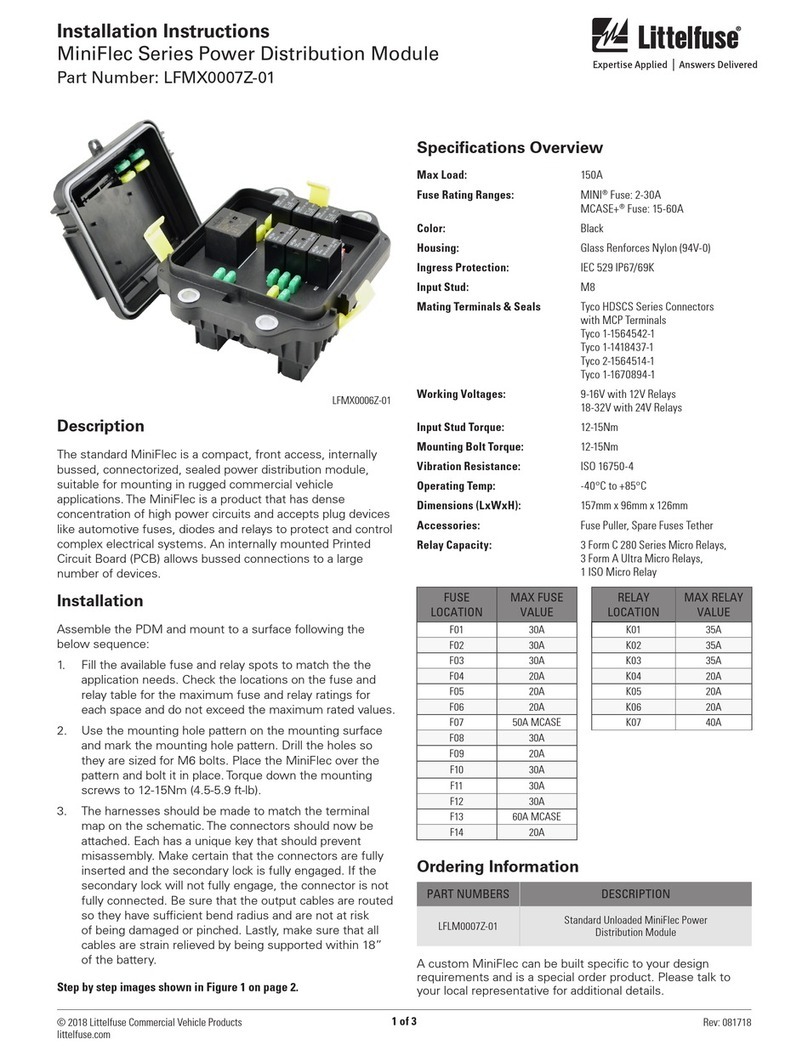
Littelfuse
Littelfuse MiniFlec Series Installation sheet
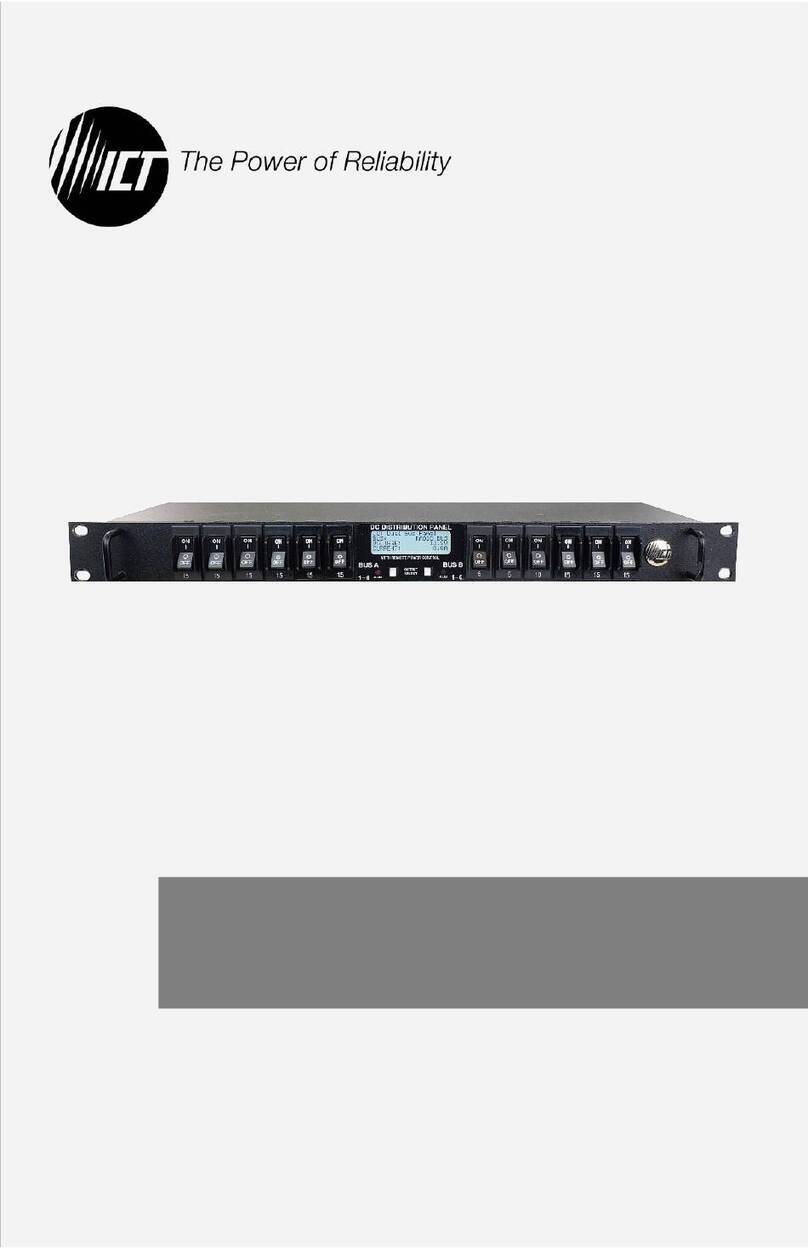
ICT
ICT Distribution 3 Series instruction manual
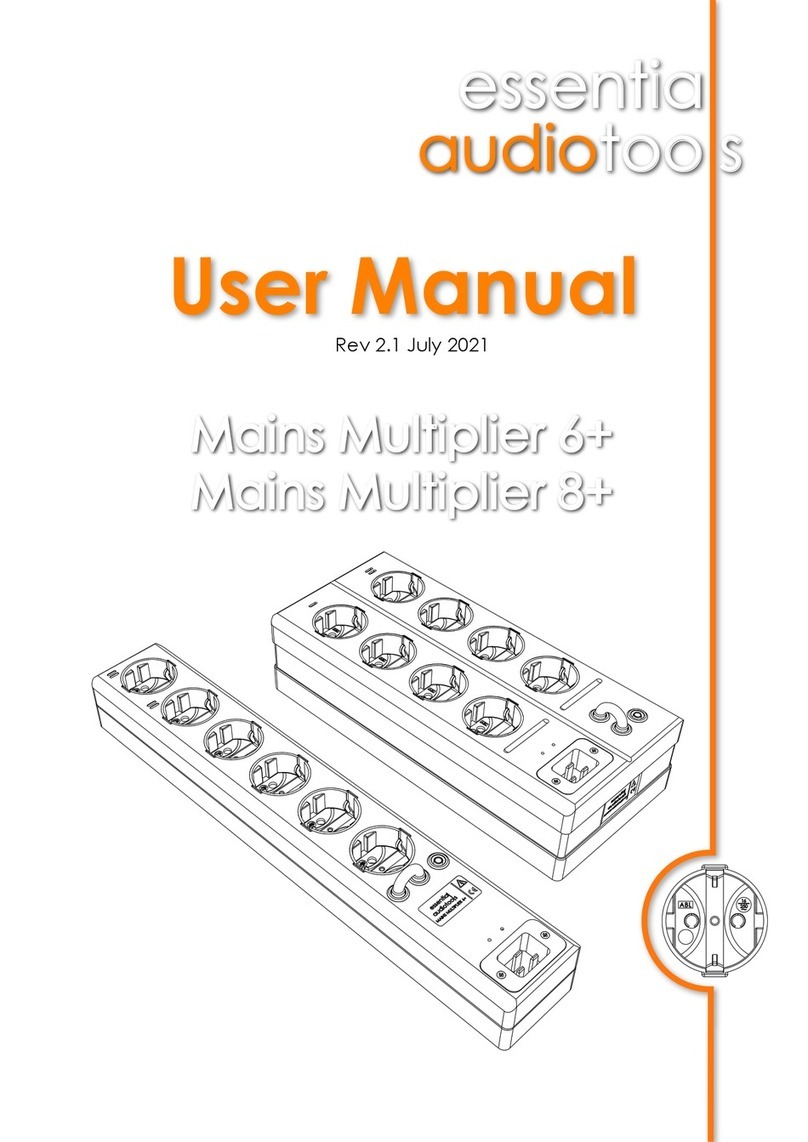
Essential Audio Tools
Essential Audio Tools Mains Multiplier 6+ user manual
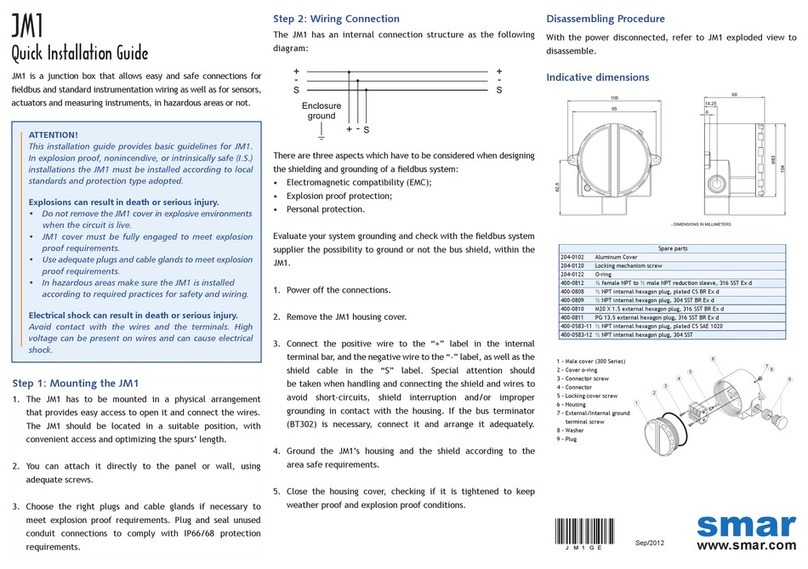
SMAR
SMAR JM1 Quick installation guide
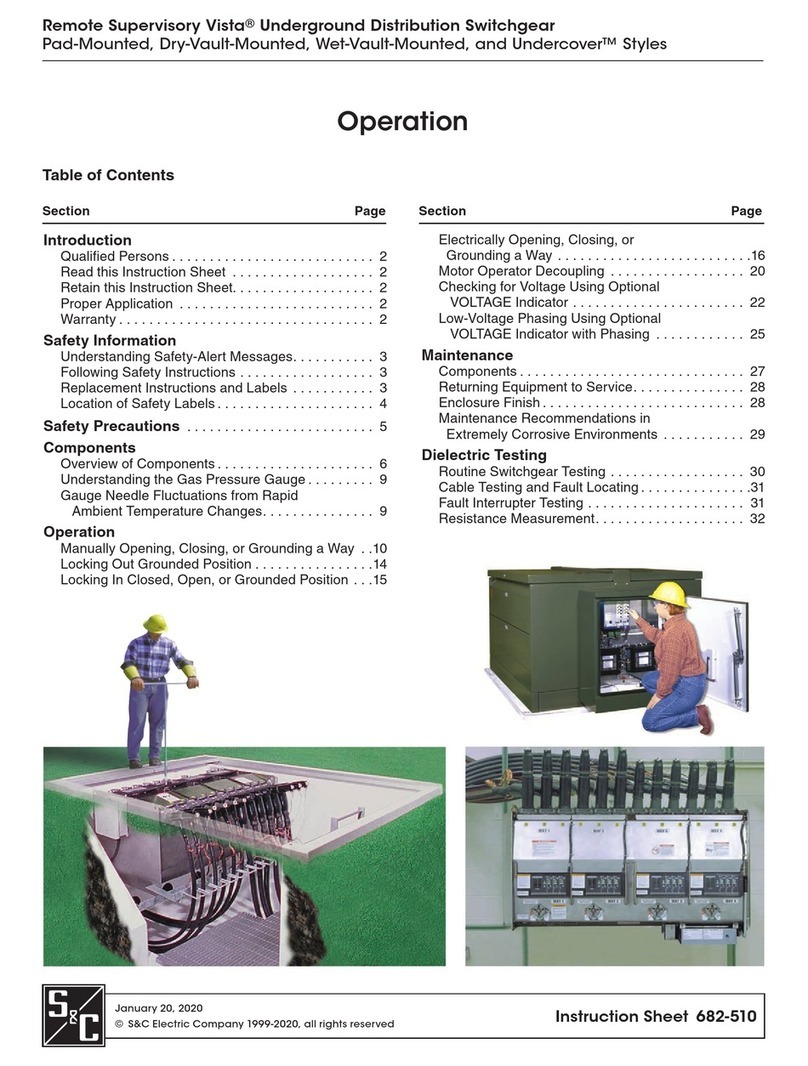
S&C
S&C Remote Supervisory Vista Operation manual

Geist
Geist ZP Series instruction manual

